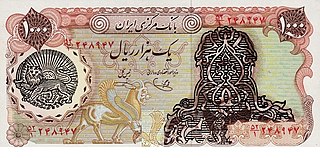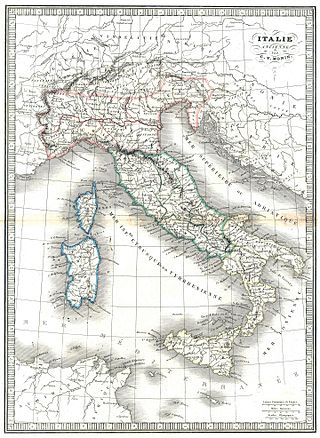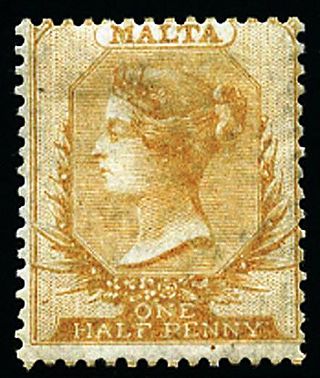Related Research Articles

A postage stamp is a small piece of paper issued by a post office, postal administration, or other authorized vendors to customers who pay postage. Then the stamp is affixed to the face or address-side of any item of mail—an envelope or other postal cover —which they wish to send. The item is then processed by the postal system, where a postmark or cancellation mark—in modern usage indicating date and point of origin of mailing—is applied to the stamp and its left and right sides to prevent its reuse. Next the item is delivered to its addressee.

An overprint is an additional layer of text or graphics added to the face of a postage or revenue stamp, postal stationery, banknote or ticket after it has been printed. Post offices most often use overprints for internal administrative purposes such as accounting but they are also employed in public mail. Well-recognized varieties include commemorative overprints which are produced for their public appeal and command significant interest in the field of philately.
This is a partial timeline of significant events in postal history, including dates and events relating to postage stamps.

Airmail is a mail transport service branded and sold on the basis of at least one leg of its journey being by air. Airmail items typically arrive more quickly than surface mail, and usually cost more to send. Airmail may be the only option for sending mail to some destinations, such as overseas, if the mail cannot wait the time it would take to arrive by ship, sometimes weeks. The Universal Postal Union adopted comprehensive rules for airmail at its 1929 Postal Union Congress in London. Since the official language of the Universal Postal Union is French, airmail items worldwide are often marked Par avion, literally: "by airplane".

An airmail stamp is a postage stamp intended to pay either an airmail fee that is charged in addition to the surface rate, or the full airmail rate, for an item of mail to be transported by air.

This is an introduction to the postal and philatelic history of Italy.

Aerophilately is the branch of philately that specializes in the study of airmail. Philatelists have observed the development of mail transport by air from its beginning, and all aspects of airmail service have been extensively studied and documented by specialists.

This is an overview of the postage stamps and postal history of Australia. encompassing some history of the Australian colonies and the main stamp issues that followed the takeover of the colonies as well as later issues and also an precis of the external territories.
This is a survey of the postage stamps and postal history of Iraq. It includes special uses under the Ottoman Empire as well as occupation issues.

In philatelic terminology a letter sheet, often written lettersheet, is a sheet of paper that can be folded, usually sealed, and mailed without the use of an envelope, or it can also be a similar item of postal stationery issued by a postal authority. Letter sheets derive from the form in which written correspondence was made up before the mid-19th century—letters were written on one or more sheets of paper that were folded and sealed in such a way that the address could be written on the outside.

The postal history of Malta began in the early modern period, when pre-adhesive mail was delivered to foreign destinations by privately owned ships for a fee. The earliest known letter from Malta, sent during the rule of the Order of St John, is dated 1532. The first formal postal service on the islands was established by the Order in 1708, with the post office being located at the Casa del Commun Tesoro in Valletta. The first postal markings on mail appeared later on in the 18th century.

The postage stamps and postal history of Israel is a survey of the postage stamps issued by the state of Israel, and its postal history, since independence was proclaimed on May 14, 1948. The first postage stamps were issued two days later on May 16, 1948. Pre-1948 postal history is discussed in postage stamps and postal history of Palestine.
The postage stamps and postal history of Palestine emerges from its geographic location as a crossroads amidst the empires of the ancient Near East, the Levant and the Middle East. Postal services in the region were first established in the Bronze Age, during the rule of Sargon of Akkad, and successive empires have established and operated a number of different postal systems over the millennia.

United States airmail was a service class of the United States Post Office Department (USPOD) and its successor United States Postal Service (USPS) delivering air mail by aircraft flown within the United States and its possessions and territories. Letters and parcels intended for air mail service were marked as "Via Air Mail", appropriately franked, and assigned to any then existing class or sub-class of the Air Mail service.

This is a survey of the postage stamps and postal history of Jordan, formerly Transjordan.

This is a survey of the postage stamps and postal history of Fezzan and Ghadames, both now part of Libya.
The 1918 Curtiss Jenny Air Mail Stamps were a set of three Airmail postage stamps issued by the United States in 1918. The 24¢ variety was the first of the stamps to be issued, and was in fact, America's first Airmail stamp.. The 16¢ and 6¢ varieties were issued later in the year to reflect reductions in the postage rate. It features the image of the Curtiss JN-4 airplane.

Postage rates in Russia have changed multiple times in the period 1917 to present. They have been introduced by the Soviet and Russian Federation governmental organs and agencies and reflected in alteration of stamp denominations.
References
- 1 2 3 4 5 6 Proud, 2006, p. 85, 86.
- 1 2 3 Bale, 2000, p. xv, 162.
- 1 2 3 4 5 6 Proud, 2006, p. 85.
- 1 2 3 4 5 6 7 Bale, 2000, p. xv.
- 1 2 Bale, 2000, p. xv, 164, 166.
- 1 2 3 4 5 6 7 8 Proud, 2006, p. 86.
- ↑ Bale, 2000, p. xv, 166.
- ↑ Bale, 2000, p. xv, 166, 170.
- 1 2 3 4 5 6 Bale, 2000, p. xv, 167.
- ↑ Proud, 1985, p. 89.
- ↑ Proud, 2006, p. 87.
- ↑ Bale, 2000, p. 167.
- ↑ Proud, 2006, p. 85, 86, 88.
- ↑ Bale, 2000, p. xv, 170.
- ↑ Proud, 2006, p. 85, 86, 97.
- ↑ Proud, 2006, p. 97.
- ↑ Proud, 2006, p. 85, 86, 101.
- ↑ Bale, 2000, p. xv, 173.
- ↑ Proud, 2006, p. 85, 86, 87.
- 1 2 3 Bale, 2000, p. xv, 174.
- ↑ Proud, 2006, p. 86, 87.